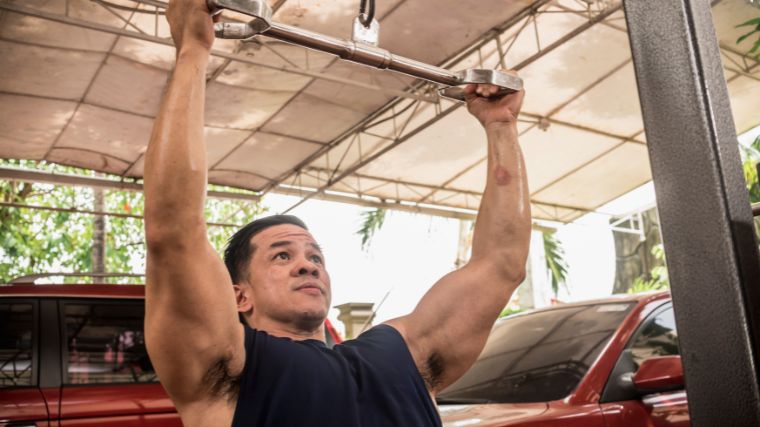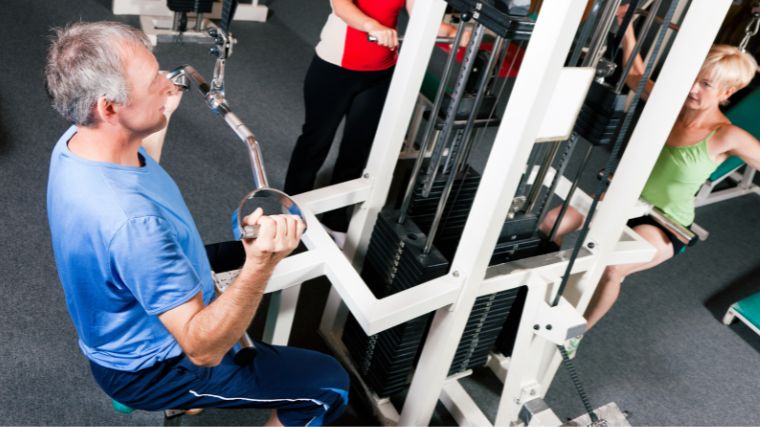Chances are, you’re one of the countless gym goers who frequents a weight room each week with a goal of broadening your back. While the traditional lat pulldown with a pronated grip (palms facing away from you) is a superb exercise, you may find it uncomfortable, awkward, or just plain boring.
You might be in the market for an adjustment to your pulldown game. Why not try the neutral-grip pulldown instead? Even if you aren’t nursing any sort of shoulder discomfort, neutral-grip pulldowns are easier to perform, more comfortable for most folks than the alternatives, and build heaps of muscle in the process.

The right pulldown grip will help you to achieve a fuller contraction of your lats, maintain healthy shoulders, and minimize the involvement of your biceps as you achieve your aim of building a strong, wide back.
- How to Do the Neutral-Grip Pulldown
- Neutral-Grip Pulldown Sets and Reps
- Common Neutral-Grip Pulldown Mistakes
- Neutral-Grip Pulldown Variations
- Neutral-Grip Pulldown Alternatives
- Muscles Worked by the Neutral-Grip Pulldown
- Benefits of the Neutral-Grip Pulldown
- Who Should Do the Neutral-Grip Pulldown
- Frequently Asked Questions
How to Do the Neutral-Grip Pulldown
Whether you’re familiar with any form of pulldown exercise or not, the basic concept behind all pulldowns remains the same. You’re going to anchor your body to a fixed position — usually at a dedicated lat-pulldown station — and grab the handles of the bar.
The “V-bar” attachment is what you’ll probably end up using for the neutral-grip pulldown. It’s a pyramid-shaped handle that you can find in most gyms. However, if your pulldown station comes with two separate cables, you can perform the exercise that way as well.
Step 1 — Anchor Your Body

Sit upright in the lat pulldown station with your feet flat on the floor. Adjust the leg pad (usually with a selector pin) so that your body will remain squarely anchored to the seat once the exercise begins.
Coach’s Tip: If you’re seated at a lat-pulldown station requiring you to grasp the weight before sitting down, make sure to leave yourself enough clearance room between your legs and the pads to easily slide your legs beneath the pads and take a seat.
Step 2 — Grab the Bar

Reach up and grab the handles of the neutral-grip bar and wrap your fingers firmly around each handle.
Coach’s Tip: If you are prone to experiencing sweaty palms and are worried about the weight slipping out of your hands, you may want to consider a remedy like lifting gloves or chalk.
Step 3 — Pull the Bar

Activate your lats and bend at the elbows to pull the bar toward your upper chest in a controlled fashion. Pause as the bar gently makes contact with your chest.
Coach’s Tip: To ensure that your lats are immediately engaged in the exercise, retract your scapulae by pulling your shoulders down before you begin to pull.
Neutral-Grip Pulldown Sets and Reps
When you do neutral-grip lat pulldowns, no matter how heavy or light your training will be, it’s a simple matter of using a selector pin to choose the appropriate weight for you and then pulling away. To focus on strength gains, you’ll want to keep your repetitions low and test the boundaries as to the number of plates you can move.
[Read More: The Best Foods for Energy Before, During, and After Your Workouts]
To focus on endurance, you’re going to maintain a much higher rep count to see just how many reps you can complete with a weight until your muscles finally give in. Focusing on size takes a hybrid approach with a weight total and rep count that lands between muscle mass and endurance. In all three cases, you want to maintain clear control over the weight.
- For Muscle Mass: Perform three to four sets of 10 to 12 reps, leaving one to two reps in the tank for each of your first two sets.
- For Strength: Do five sets of five reps using a challenging weight. You should feel like you couldn’t possibly complete another rep in each set.
- For Endurance: Complete two to three sets of 15 to 20 reps. You should feel like you couldn’t perform an additional rep after the last rep of your final set.
Common Neutral-Grip Pulldown Mistakes
In a general sense, you can think of the neutral-grip pulldown as a safer exercise than many free-weight rows for your back. However, this false sense of security might lead you to make a few all-too-common mistakes that might minimize your progress or even result in an injury if you’re not paying close attention to your form.
Rocking Too Far Backwards
The advantage of the lat pulldown station is that it enables you to pull the weight down at an angle that effectively targets the lats. However, leaning backwards so far that the exercise begins to resemble a standard cable row performed vertically defeats the purpose of the exercise. Ensure that your torso is roughly perpendicular to the floor. You can lean back slightly to pull the handle down to your chest, but don’t rock back and forth or use unnecessary momentum.
Not Angling Back Far Enough
Conversely, if you remain perfectly vertical during your neutral-grip pulldown sets, you’ll restrict the ability of your shoulders and elbows to get back behind your torso, which is an essential component of the exercise.

Don’t compromise the efficacy of the neutral-grip pulldown by forcing a perfectly vertical torso.
Not Completing the Pulldown
Individual anatomies vary, but if you only pull the handles to the level of your chin, you’ll prevent the elbows from achieving a state of full extension behind your torso, which is the point at which your lats are fully flexed and engaged in the exercise. If you struggle to achieve a full range of motion, you’re probably lifting too heavy.
Neutral-Grip Pulldown Variations
The neutral-grip pulldown is, technically, a variation of the standard pulldown motion. However, you can modify it even further to suit your needs.
Overhand Lat Pulldown
This is often thought of as an ordinary lat pulldown and will probably be the first version you learn. To do it, simply grab the bar with an overhand grip and pull the weight in the same manner in which you would execute a neutral-grip lat pulldown.
[Read More: Nutrition for Athletes — How to Eat for Muscle and Performance]
There is potential to draw upon more overall power when performing this version of the exercise, but it also means you have to be very careful not to transfer too much ownership of the movement over to portions of the back that you’re not intending to work.
Single-Arm Pulldown
If you’re in the market for some unilateral, or single-sided, muscle stimulation, you can try the single-arm pulldown. You’ll need a one-handed cable handle attachment for this one, though.
The single-arm pulldown allows you to focus on hammering one side of your back at a time, rather than pulling with both arms together. Bilateral pulling may mask imbalances in strength which, if not addressed, can worsen and become a real detriment to your performance.
Kneeling Neutral-Grip Pulldown
This variation involves stepping away from the pulldown machine and shifting your workout over to another cable-based workout station. While this alternative doesn’t provide you with as much stability, you will get one heck of a core workout in the process.
The increased core engagement also makes the kneeling variation a viable progression option if you’re still working your way up to your first pull-up.
Neutral-Grip Pulldown Alternatives
As beneficial as neutral-grip pulldowns can be, not every gym is going to offer a bar with a grip capable of accommodating your desire to perform this exercise. If you find yourself without any neutral-grip bars at your disposal, here are a few training options that will enable you to reap similar benefits from your training.
Close-Grip T-Bar Row
You can closely mimic the movement pattern of the neutral-grip pulldown by wedging a barbell into a corner and using the V-bar handle to perform T-bar rows instead. If the pulldown station is occupied, this swap will definitely work in a pinch.
Note, though, that the T-bar row will tax your lower back quite a bit, as you have to perform it while hinged over rather than sitting comfortably in a seat. The stimulation your arms and lats receive should be mostly the same.
Barbell Row
This is a compound movement that enables you to simultaneously train virtually all of the muscles in your back at once. Simply grab a barbell from the floor with an overhand grip, hinge at the hips, pin your shoulders back, and pull it up to your belly.
The barbell row is excellent for total back development, but it does not grant special focus or consideration to the lats; it trains them in concert with all of the other muscles. Also, while this exercise is considered basic, you need exceptional posterior chain strength to maintain good posture during your set.
Muscles Worked by the Neutral-Grip Pulldown
Your back is composed of a multitude of muscles, and the neutral-grip pulldown is going to incorporate all of those muscles to some extent. While this may sound like a great thing — and it might be depending on your specific goals or time limitations — your primary area of focus during a set of neutral-grip pulldowns is going to your lats.
[Read More: Build a Titanic Torso with These Bodybuilding Chest & Back Workouts]
Gaining a fuller understanding of what each involved muscle is doing during a neutral-grip pulldown is key to determining how to minimize the activity of some of those muscles while enhancing the focus placed on your lats. Here are the muscles involved in the neutral-grip pulldown.
Latissimus Dorsi
The latissimus dorsi are the largest muscles in your upper back. Your lats primarily tie into your shoulders and insert all the way down onto your lumbar spine. This is the primary muscle being targeted during your neutral-grip pulldown session; your lats contract to pull your shoulder blades downward and draw your upper arm into your sides.
Rhomboids
Located in your upper back, your rhomboids will permit you to pin your shoulder blades closer to your spine as you pull against resistance and bring your elbows back and behind your torso.
Trapezius
Your traps have three distinct regions. They take up residence in the center of your back and contribute a lot of thickness to your upper back overall. If you’re not careful about contracting your lats, the trapezius will gladly accept a lot of the load from them, and especially on movements that require you to pull back and inward.
Biceps
Bending at the elbow as you pull the weight toward your chest is automatically going to call upon your biceps — the powerful muscles in the front of your arms — in order for you to complete the pull.

[Read More: The Complete Guide to Pre-Workout Supplements]
Because nearly all pulling movements require some participation from your biceps (despite the fact that they’re rarely intended to be the driving force behind the motion), you’ll need to be extremely careful not to let your biceps steal the show at the expense of your back.
Benefits of the Neutral-Grip Pulldown
No matter what activity you’re engaged in, whether it’s golfing, bowling, or simply walking, a strong and healthy back can only benefit you. Regular performance of the neutral-grip pulldown will provide you with a sturdy posterior chain that you can rely on in every scenario you encounter in your day-to-day life.
Builds a Broad Back
Plainly stated, the latissimus dorsi is the largest set of muscles in your back, and the neutral-grip pulldown targets this muscle group very effectively. It even emphasizes the work of your lats over your other back muscles in ways that few other exercises can.
Strengthens Your Posterior Chain
Not only will the neutral-grip pulldown cause your back to grow, but it will also increase your overall back strength in a big way due to the high loading potential and equally high propensity to utilize progressive overload.
Upgrades Your Posture
The very nature of how the neutral-grip lat pulldown requires you to position yourself — upright with your chest out and your shoulders back — ensures that your body is going to get a lesson in proper posture. The fact that your back will be strengthened in the exact position it should be in while you’re living your everyday life is an added benefit.
Improves Your Connection to Muscles You Can’t See
Many people have a preference for training their chests, abdominals, and shoulders instead of their backs, and one of the reasons for this is because they prioritize the muscles they can see in action while they’re being trained.

[Read More: The Definitive Guide to Bodybuilding Meal Prep]
Because the resistance provided by neutral-grip pulldowns is both safe and stable, it makes it very easy to develop a sound mind-muscle connection with your back and grow parts of your body you don’t typically see in the mirror.
Who Should Do the Neutral-Grip Pulldown
There are plenty of lat pulldown variations you can choose from, but you may fall into a group of people that can benefit from the neutral-grip pulldown in particular. If you play a certain sport or have trouble “connecting” with your back muscles in the weight room, you may want to start performing this back-builder.
Athletes Who are Back-Dependent
Several athletes enjoy a direct correlation between back strength and improved performance, so boosting the load-bearing capacity of the largest muscles in your back will go a long way toward enhancing your output in whatever sport you play.
This is true of pulling-based racing sports like rowing, skiing, and swimming, and also of most sports that require physically controlling your opponents, like football, hockey, and lacrosse.
If You Can’t Feel Your Back in Action
There are plenty of great back exercises that require pulling and rowing, but many of them make it challenging to move the weight without feeling like you’re initiating the movement in your arms. This makes it difficult to lift in a manner that makes you feel connected to the very muscles that you’re supposed to be targeting.

The easy-to-control nature of the neutral-grip pulldown makes it much simpler to make adjustments on the fly, and to control the movement from start to finish. This permits you to concentrate on moving the weight carefully and thoroughly, keeping all of the appropriate muscles engaged while you go.
Build Your Back, Better
If you wish to become the proud owner of a well-rounded, high-functioning back, the inclusion of some form of pulldown in your training routine is practically mandatory. The neutral-grip pulldown may not be the most common pulldown method performed in the gym, but it can be the variation that’s right for you.
If you’re an athlete, pulldowns can also help you to focus on watching your teammates’ backs on the playing field, since you know that yours can already withstand whatever the opposition intends to throw at it.
FAQs
Since the neutral-grip pulldown addresses so many muscles, we’re sure that all of this information has sparked a few unanswered questions. We’ve got some answers for you below.
If I do neutral-grip pulldowns, do I need to do any other pulldowns?
Not necessarily. There are a lot of factors that can go into determining what a person chooses to fit into their training routine for a specific set of body parts. Even for the majority of individuals who desire to train each component of the back separately, one type of pulldown exercise is usually sufficient for the sake of health unless they have a very specific training goal.
If I do neutral-grip pulldowns, do I need to do any other back exercises?
You should consult with a physician before you begin any form of training program, but if you’re an otherwise healthy adult, a neutral-grip pulldown — while an excellent start — places an emphasis on specific muscles of the back while contributing less to the development of others.
If your objective is to take a balanced approach to back development, supplementing with exercises like T-bar rows, standing barbell rows, and back extensions would contribute to a well-rounded set of back muscles.
I see that my shoulders are involved in the neutral-grip pulldown. Should I still train my shoulders separately?
Your shoulders are automatically involved in a lot of arm-based movements like pulldown, pull-ups and push-ups simply because of the way they anchor your arms to your torso. Although they do a fair amount of work during neutral-grip pulldowns and other exercises, it is still useful for you to provide your shoulders with their own day of isolated training to maximize their strength and health.
Featured Image: Nikolas_jkd / Shutterstock